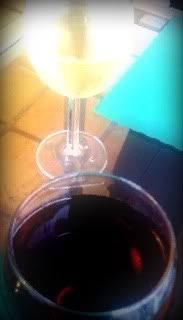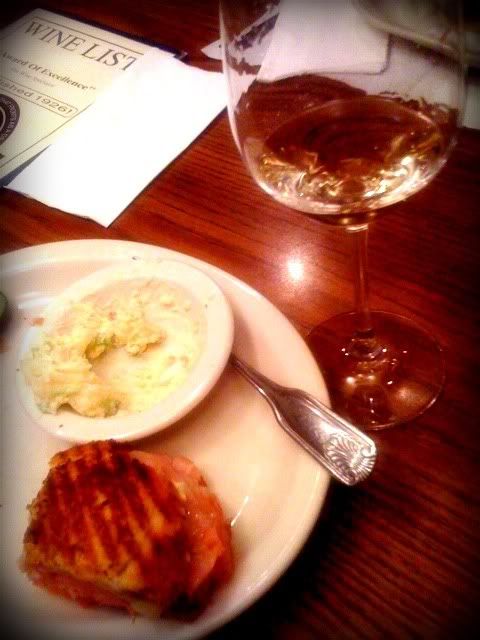 |
| Jean-Luc Colombo |
French winemaker
Jean-Luc Colombo was in Los Angeles recently for a series of tastings and dinners to promote his wines. The walk-around tasting at
Monsieur Marcel in Beverly Hills was staged by
Ian Blackburn's
Learn About Wine education group. Blackburn greeted me with the news that Colombo was in rare form. “He won’t stop talking about non-irrigated farming. He says irrigation destroys
terroir.” Well, he’s had a lifetime to think about it.
Colombo became interested in wine at an early age. Back in Marseilles, he started a quest to make wine which was as good as his mother’s cooking. Colombo is a devotee of the Syrah grape, so he was quite naturally drawn to the northern Rhone Valley. The first vineyards he bought for himself were on a granite hillside overlooking the tiny village of Cornas. They call it the birthplace of Syrah - in fact, Syrah is the only grape planted there. That’s alright with Colombo.
 |
| Ian Blackburn |
The winemaker shook things up a bit in Cornas with his fruit-forward tendencies, which flew in the face of traditional ways. Colombo thought wine shouldn’t be locked away for years in a barrel before being released and enjoyed. He is described on the winery website as having deep “respect for the unique qualities of each and every
terroir, and uncompromising support of a sensible alliance between traditional approaches to vineyard management and a modern understanding of the life cycle of the vine.” He also departs from tradition by labeling his wines varietally - Syrah, Viognier, etc.
Colombo later acquired vineyards in the Southern Rhône Valley and Languedoc regions. He farms his vineyards organically and sees his grapes not as kings of the hillside, but residents of it. His wines are imported by
Palm Bay International. The prices listed here are retail, found online, and they may not be exact. He is what I tasted:
WHITE
La Belle de Mai Saint-Peray 2011, $42
Saint-Peray is in the Northern Rhône, the mirror image of Cornas. All the wines of Saint-Peray are white. La Belle de Mai is 80% Roussanne and 20% Marsanne taken from 80-year-old vines on steep limestone and granite slopes. Fermentation and malolactic takes place in mostly neutral barrels, while aging on the lees last ten months with weekly stirring. This method of leaving the wine in contact with the yeast during aging brings out some amazing aromas of nuts, flowers and lemons. This wine is very full-bodied, creamy and buttery. Colombo says he is “very proud of this wine.”
Les Abeilles de Colombo 2012, $12
This white from the Côtes du Rhône is 80% Clairette and 20% Roussanne. Stainless steel fermentation, then aged on the lees - 15% in barrels and 85% in tanks. Apple, floral, mineral. Very fresh.
La Redonne 2011
Another Côtes du Rhône blanc, the grapes are 70% Viognier and 30% Roussanne. Fermented in steel tanks, 20% is aged on the lees in barrels with the remainder in steel. Minerals, oak, floral, honey.
La Violette Viognier 2011, $14
This is 100% Viognier from the Languedoc region in southern France. Fermentation takes place in steel tanks (80%) and barrels (20%). The wine ages for six months - on the lees, of course - with only 70% in tanks and the rest in barrels. Minerals, peaches, almonds.
ROSÉ
Cape Bleue Rosé 2012, $12
This pink wine is made from 67% Syrah and 33% Mourvèdre grapes from Provence. The traditional saignée method of extraction - bleeding the juice from the grape skins - is followed by two or three weeks fermentation in steel tanks. Minerals and strawberry, nice savory notes.
RED
La Louvée Syrah Cornas 2010, $50
This single-vineyard wine is made from 70-year-old vines growing in granite soils. It is fermented in stainless steel tanks with skin contact of one month, then aged 22 months in oak - 15% of which is new. Extremely floral blueberry nose, mineral-driven blueberry palate. Oak spice stays around on the finish.
Les Ruchets Cornas 2010 Syrah, $60
These grapes are from 90-year-old vines in a single vineyard on ancient Roman terraces.
Stainless steel fermentation precedes aging of 22 months in oak, a third of it new. Minerals, delightful dark fruit, oak spice.
Terres Brulees Cornas 2010 Syrah, $50
Fermented in steel, with 21 months in oak - 15% new, 85% neutral. Burnt caramel nose, blueberry with a caramel edge on the palate. Extremely rich and completely delightful.
Les Bartavelles Chateauneuf-du-Pape 2011,
45% Syrah, 35% Grenache and 20% Mourvèdre, the grapes are grown in the CDP's galet soil. Stainless steel fermentation, then 18 months in neutral oak. Minerals, berries, spice. Lovely, perfect use of oak..
La Violette Syrah 2011, $15
100% Syrah from Languedoc. Fermentation in tanks is backed up with a year of aging, ten percent in oak and the remainder in steel and concrete tanks. Floral nose, mineral palate. Black and blue berries, herbs on finish.







